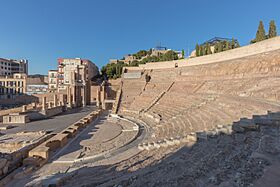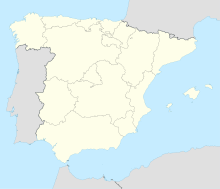Roman Theatre (Cartagena) facts for kids
|
Teatro Romano de Cartagena
|
|
 |
|
| Location | Cartagena, Spain |
|---|---|
| Region | Murcia |
| Coordinates | 37°35′58″N 0°59′03″W / 37.5995°N 0.9841°W |
| Type | Archaeological site, monument, Roman theatre |
| History | |
| Builder | Gaius Caesar |
| Founded | 5–1 BCE |
| Abandoned | 425 CE |
| Cultures | Roman Empire |
| Site notes | |
| Excavation dates | 1988–2003 |
| Condition | Restored |
| Public access | Yes |
The Roman Theatre of Cartagena is an ancient Roman theatre located in what was once the Roman city of Cartago Nova. This city is now known as Cartagena, Spain. It was built between 5 and 1 BCE and could hold about 6,000 people. People came here to watch plays and performances during the time of ancient Rome.
Contents
Where is the Roman Theatre Located?
The Roman Theatre of Cartagena is in a coastal city in southeastern Spain. Cartagena has a dry Mediterranean climate. This means it has hot summers, not much rain, and often strong winds. Being close to the sea, the theatre is exposed to salt and sea breezes. These can cause the old stone to wear down over time.
The Romans were smart about where they built the theatre. They chose a spot near the port but far from a swampy area. They also used the natural slope of a hill. This helped them build the seating area facing north, protected from strong easterly winds. They even thought about the sun! The theatre was built so its main line pointed towards the sunrise during the winter solstice.
The area around the theatre has always been a busy part of the city. This is why the theatre stayed buried for so long. For many years, this part of the old town was run down. But bringing the Roman Theatre back to life has helped make the area lively again. Today, it's a busy place where ancient ruins mix with modern buildings. This also means the theatre is affected by city traffic and vibrations.
The theatre is also next to some of Cartagena's most famous buildings. These include the Cathedral, the Town Hall, a medieval castle, and the port. This makes it a very popular spot for tourists. More than 200,000 people visit each year. All these visitors can also cause some wear and tear on the ancient site.
A Look Back: The Theatre's History
The story of the theatre begins in Roman times. Back then, Cartagena was called Carthago Nova and was part of the Roman Empire. During the rule of Emperor Augustus (63 BCE - 14 CE), the theatre was built. It used the slope of La Concepcion hill and was close to the port. This way, the grand building could be seen from the sea, showing how important the city was.
The theatre opened in 1 BCE and was used for about 200 years. It needed some repairs during that time. Before the theatre was built, there was a Roman house on the same spot. This house was taken down on purpose to make way for the theatre.
Around the 5th century CE, after a fire damaged much of it, the theatre was taken apart. Its stones and other parts were used to build a market. Later, in Byzantine times (6th-7th centuries), a shopping area was built over its ruins.
After the Christians took over, the church of Santa María la Vieja was built. This church is now the city's cathedral. By the early 1900s, the area was a busy neighborhood. But in the 1960s and 70s, richer people moved out, and the area became run down.
To help fix this, local leaders planned to build a crafts center in 1988. When construction started, they began digging. They found many layers of old buildings and beautiful stone pieces. In 1990, they finally realized they had found parts of the Roman Theatre of Carthago Nova.
Between 1996 and 2003, almost the entire theatre was dug up. It was amazing to see it in all its glory again! In 2003, the Roman Theatre Foundation was created. Its goal was to help restore the monument. A famous architect named Rafael Moneo was chosen for the project. He planned to connect the theatre with the modern city. He also wanted to make sure it was preserved and shown to the public for learning and culture.
Protecting the Ancient Site
The digging work was paid for by the City of Cartagena, the Region of Murcia, and the Cajamurcia Foundation. Archaeologists Sebastián Ramallo Asensio and Elena Ruiz Valderas led the teams. They worked with many experts to understand the theatre's amazing design and meaning. The goal was to restore the theatre and create a museum for the items found there. At the same time, they started the process to declare it a "Bien de Interés Cultural" (Asset of Cultural Interest), which is a special protection status in Spain.
Other groups also helped with studies during the excavations. The University of Murcia's archaeology department helped with some digging. A company called I.T.C. studied how materials could be strengthened. And Arte-Lab, S.L. tested the different types of mortar used in the theatre's seating area.
After the digging, architect Rafael Moneo was put in charge of the full restoration project. He worked closely with the archaeology and restoration teams. The Roman Theatre Foundation, created in 2003, helped speed up the work. This foundation brought together the Region of Murcia, the City Council of Cartagena, and the Cajamurcia Foundation. Their teamwork allowed the project to move forward smoothly. The Museum and Roman Theatre finally opened in 2008.
Today, the Roman Theatre of Cartagena is officially an Asset of Cultural Interest in Spain. It is protected by national laws like Law 16/1985 on Spanish Historical Heritage. It also has regional protection from the Autonomous Community of Murcia. City planning rules in Cartagena also protect it. For example, they stop heavy construction nearby. This means that throughout its recent history, the theatre project has had to follow strict rules. These include limits on digging and building, and requirements to make new parts blend in well.
Bringing the Theatre Back to Life
After more than 10 years of digging, the restoration project began in 2003. Architect Rafael Moneo was chosen to lead it. The main goal was to protect the theatre's history and original look. Moneo worked with archaeologists Sebastián Ramallo and Elena Ruiz, and restoration expert Isabel García-Galán. They focused on making the theatre's ruins strong again.
After the theatre was uncovered, experts discussed how to restore it. They decided the main purpose was for it to be a monument open to visitors. They wanted people to enjoy and learn about Roman Cartagena. Many valuable items were found during the digging. These included beautiful marble column tops, red stone columns, altars, and special plaques. This led to the idea of including a Roman Theatre Museum.
Moneo's design connects the old and new buildings with a museum path. This path goes from the sea level up to the theatre. The museum is like a journey that ends with the amazing view of the Roman Theatre. Moneo said the museum was designed as a "promenade" (a walk) from the sea to the higher ground. This walk leads to the "unexpected appearance of the theatre's imposing space." Along this path, visitors see the items found during the excavations.
The project also aimed to "make a city." This means Moneo thought about the public spaces of Cartagena, not just the museum's inside. He tried to connect the project with other historic buildings nearby. For example, parts of the Old Cathedral (Santa María la Vieja) are built right over some of the theatre's seating. Also, parts of the Roman house that was there before the theatre are still preserved inside the museum.
For the theatre itself, protecting its history was the top priority. The goals were to stop damage from weather and other factors. They also wanted to strengthen the theatre's parts. And they aimed to rebuild some missing sections to help visitors understand the monument better.
The restoration project wanted to make the theatre clearer for visitors. So, they rebuilt parts of the seating that had disappeared. They did this without changing the original look. They also reinforced the original parts. Entrances were replaced for tours, and the stage front was partly restored using original pieces.
It was also important that any new work could be removed without harming the original structure. This is called "reversibility." For example, new parts were separated from old ones with special fabric strips. This makes it easy to remove the new work if needed. They used real materials and Roman building methods where possible. This included lime mortar and local stones, just like in ancient times.
The main stone used was Tabaire sandstone. This stone is soft and porous, which made it easy to work with. But it also makes it fragile and easily damaged by rain, humidity, salt, and pollution. Over centuries, wind, sea breezes, and constant use also caused the theatre to wear down.
Studies showed specific damage to the Tabaire sandstone. This included holes, peeling layers, flaking, color changes from plants, and erosion that made carved details less clear.
One part of the stage, where theatre stones were reused for a 5th-century market, was left as it was found. A missing section of the seating was rebuilt using rubble. Heavily eroded areas were mostly left untouched, showing the idea of minimal intervention. The project also made sure new treatments were noticeable but didn't change the original shape. They used materials like ethyl silicate and nanolime, which are compatible with the original stone. These treatments can be removed if needed, keeping the reversibility goal.
In short, Rafael Moneo's restoration of the Roman Theatre of Cartagena is a major project in saving old buildings in Spain. It brought the theatre back into the city while keeping its original structure safe and strong for the future. The Roman Theatre Museum and its Foundation are now planning to dig up and improve the area behind the stage.
Gallery
-
Since 1975, the Christmas nativity scene in Cartagena has been set up in Plaza de San Francisco. It's a tradition to include modern buildings like the Roman Theatre in the background.
Finds at the Cartagena Archaeological Museum
-
An altar of Jupiter found in the Roman theater of Cartagena.
See also
 In Spanish: Teatro romano de Cartagena para niños
In Spanish: Teatro romano de Cartagena para niños
- List of Roman theatres
External links
- Multimedia Resources
- Official page: http://www.teatroromanocartagena.org/














